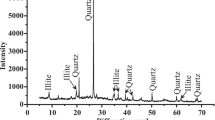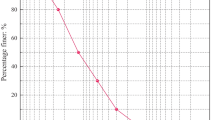Abstract
The laboratory test and numerical calculation were carried to explore the durability and service life of the grout-reinforced geological foundation. In this paper, the simulation test for determining penetration properties of grouting was carried out with the self-designed experimental device, and the mechanical properties and permeability coefficient were obtained. The results show that the seawater ions corroded the grout-reinforced body, and the properties had deteriorated. Meanwhile, the service life cycle prediction model was obtained according to the weakening of the deformation modulus. The calculated results demonstrate that the grout-reinforced body will fail in 29–63 years, which was far less than the concrete service life (100–120 years). In addition, the compressive strength obtained after the end of the service life was obtained as 9–27 MPa, less than the concrete strength at the same curing age. In conclusion, the failure of marine engineering is not only caused by concrete but more by the failure of the weak geological foundation strengthened by the grouting reinforcement.



















Similar content being viewed by others
References
Xue, Y.; Zhou, B.; Li, S.; Qiu, D.; Zhang, K.; Gong, H.: Deformation rule and mechanical characteristic analysis of subsea tunnel crossing weathered trough. Tunn. Undergr. Sp. Tech. 114, 103989 (2021)
Shekari, M.R.: A coupled numerical approach to simulate the effect of earthquake frequency content on seismic behavior of submarine tunnel. Mar. Struct. 75, 102848 (2021)
Al-Rabiah, A.R.: Durability requirements for reinforced concrete construction in aggressive marine environments. Mar. Struct. 3, 285–300 (1990)
Duan, A.; Dai, J.; Jin, W.: Probabilistic approach for durability design of concrete structures in marine environments. ASCE. 27, 1943–5533 (2014)
Cheng, S.; Shui, Z.; Sun, T.; Gao, X.; Guo, C.: Synergistic effects of sulfate and magnesium ions on chloride diffusion behaviors of Portland cement mortar. Constr. Build. Mater. 229, 116878 (2019)
Liu, P.; Chen, Y.; Yu, Z.; Lu, Z.: Effect of sulfate solution concentration on the deterioration mechanism and physical properties of concrete. Constr. Build. Mater. 227, 116641 (2019)
Qiao, C.; Suraneni, P.; Weiss, J.: Damage in cement pastes exposed to NaCl solutions. Constr. Build. Mater. 171, 120–127 (2018)
Xie, J.; Wei, M.; Huang, P.; Zhang, H.; Chen, P.: Fatigue behavior of the basalt fiber-reinforced polymer/concrete interface under wet-dry cycling in a marine environment. Constr. Build. Mater. 228, 117065 (2019)
Moffatt, E.G.; Thomas, M.D.A.: Performance of 25-year-old silica fume and fly ash lightweight concrete blocks in a harsh marine environment. Cement Concrete Res. 113, 65–73 (2018)
Sun, J.: Durability problems of lining structures for Xiamen Xiang’an subsea tunnel in China. J. Rock Mech. Geotechn. Eng. 3, 289–301 (2011)
Samimi, K.; Kamali-Bernard, S.; Maghsoudi, A.A.: Durability of self-compacting concrete containing pumice and zeolite against acid attack, carbonation and marine environment. Constr. Build. Mater. 165, 247–263 (2018)
Shen, X.; Liu, Q.; Hu, Z.; Jiang, W.; Lin, X.; Hou, D.; Hao, P.: Combine ingress of chloride and carbonation in marine-exposed concrete under unsaturated environment: a numerical study. Ocean Eng. 189, 106350 (2019)
Umar, M.; Fathima, N.; Mohammed, M.H.; Hemalatha, S.: Modified cement composites for protection against microbial induced concrete corrosion of marine structures. Biocatal. Agricult. Biotechnol. 20, 101192 (2019)
Kwon, S.; Lee, H.; Karthick, S.; Saraswathy, V.; Yang, H.: Long-term corrosion performance of blended cement concrete in the marine environment – A real-time study. Constr. Build. Mater. 154, 349–360 (2017)
Mahima, S.; Bahurudeen, A.; Santhanam, M.; Jayachandran, K.: Service life prediction of bagasse ash blended concrete in marine splash zone. Mater. Today : Proceed. 4, 9664–9672 (2017)
Wen, X.; Tu, J.; Gan, W.: Durability protection of the functionally graded structure concrete in the splash zone. Constr. Build. Mater. 41, 246–251 (2012)
Sepulcre-Aguilar, A.; Hernández-Olivares, F.: Assessment of phase formation in lime-based mortars with added metakaolin, Portland cement and sepiolite, for grouting of historic masonry. Cement Concrete Res. 40, 66–76 (2010)
Krishnamoorthy, T.S.; Gopalakrishnan, S.; Balasubramanian, K.; Bharatkumar, B.H.; Rao, P.R.: Investigations on the cementitious grouts containing supplementary cementitious materials. Cement Concrete Res. 32, 1395–1405 (2002)
Zhang, J.P.; Liu, L.M.; Li, Q.H.; Peng, W.; Zhang, F.T.; Cao, J.Z.; Wang, H.: Development of cement-based self-stress composite grouting material for reinforcing rock mass and engineering application. Constr. Build. Mater. 201, 314–327 (2019)
Li, Q.; Ye, X.: Surface deterioration analysis for probabilistic durability design of RC structures in marine environment. Struct. Saf. 75, 13–23 (2018)
Flint, M.M.; Baker, J.W.; Billington, S.L.: A modular framework for performance-based durability engineering: from exposure to impacts. Struct. Saf. 50, 78–93 (2014)
Castaldo, P.; Palazzo, B.; Mariniello, A.: Effects of the axial force eccentricity on the time-variant structural reliability of aging rc cross-sections subjected to chloride-induced corrosion. Eng. Struct. 130, 261–274 (2017)
Amey, S.L.; Johnson, D.A.; Miltenberger, M.A.; Farzam, H.: Predicting the service life of concrete marine structures: an environmental methodology. ACI Struct. J. 95, 205–214 (1998)
Katz, A.J.; Thompson, A.H.: Prediction of rock electrical-conductivity from mercury injection measurements. J. Geo. RES-Solid. Earch and Plants. 92, 599–607 (1987)
Su, C.D.; Tang, X.; Ni, X.M.: Study on correlation among point load strength, compression and tensile strength of coal samples (in Chinese). J. Min. Saf. Eng. 29, 511–515 (2012)
Wang, W.G.; Wang, M.L.: Error and correlation analysis of point load test (in Chinese). J. Rock. Mech. Eng. 04, 310–319 (1988)
Zhang, L.Z.: Study on penetration and reinforcement mechanism of grouting in sand layer disclosed by subway tunnel and its application (in Chinese). 242 (2017).
Mahboubi, A.; Ajorloo, A.: Experimental study of the mechanical behavior of plastic concrete in triaxial compression. Cement Concrete Res. 35, 412–419 (2005)
Ebead, U.; Lau, D.; Lollini, F.; Nanni, A.; Suraneni, P.; Yu, T.: A review of recent advances in the science and technology of seawater-mixed concrete. Cement Concrete Res. 152, 106666 (2022)
Balonis, M.; Lothenbach, B.; Le Saout, G.; Glasser, F.P.: Impact of chloride on the mineralogy of hydrated Portland cement system. Cement Concrete Res 40, 1009–1022 (2010)
Huang, X.; Hu, S.G.; Wang, F.Z.; Yang, L.; Rao, M.J.; Mu, Y.D.; Wang, C.X.: The effect of supplementary cementitious materials on the permeability of chloride in steam cured high-ferrite Portland cement concrete. Constr. Build. Mater. 197, 99–106 (2019)
Zhang, Z.Y.; Jin, X.G.; Luo, W.: Long-term behaviors of concrete under low-concentration sulfate attack subjected to natural variation of environmental climate conditions. Cement Concrete Res. 116, 217–230 (2019)
Hekal, E.E.; Kishar, E.; Mostafa, H.: Magnesium sulfate attack on hardened blended cement pastes under different circumstances. Cement Concrete Res. 32, 1421–1427 (2002)
Rostam, S.: Service life design - the European approach. Concr. Int. 15, 24–32 (1993)
Luo, X.; Zhou, X.W.; Wei, J.: Determination and application of the sharp degradation point of concrete under environmental actions. J. Earth Sci. (Wuhan, China). 17, 181–184 (2006)
Loreto, G.; Di Benedetti, M.; De Luca, A.; Nanni, A.: Assessment of reinforced concrete structures in marine environment: a case study. Corros. Rev. 37, 57–69 (2019)
Da Costa, A.; Fenaux, M.; Fernández, J.; Sánchez, E.; Moragues, A.: Modelling of chloride penetration into non-saturated concrete: case study application for real marine offshore structures. Constr. Build. Mater. 43, 217–224 (2013)
Novokshchenov, V.: Deterioration of reinforced concrete in the marine industrial environment of the Arabian Gulf—A case study. Mater. Struct. 28, 392–400 (1995)
Bayuaji, R.; Sigit Darmawan, M.; Husin, N.A.; Anugraha, R.B.; Budipriyanto, A.; Stewart, M.G.: Corrosion damage assessment of a reinforced concrete canal structure of power plant after 20 years of exposure in a marine environment: a case study. Eng. Fail. Anal. 84, 287–299 (2018)
Moradi-Marani, F.; Shekarchi, M.; Dousti, A.; Mobasher, B.: Investigation of corrosion damage and repair system in a concrete jetty structure. J. Perform. Constr. Fac. 24, 294–301 (2010)
Dousti, A.; Moradian, M.; Taheri, S.R.; Rashetnia, R.; Shekarchi, M.: Corrosion assessment of RC deck in a jetty structure damaged by chloride attack. J. Perform. Constr. Fac. 27, 519–528 (2013)
Thomas, M.D.A.; Matthews, J.D.: Performance of pfa concrete in a marine environment––10-year results. Cement Concr. Compos. 26, 5–20 (2004)
Chalee, W.; Sasakul, T.; Suwanmaneechot, P.; Jaturapitakkul, C.: Utilization of rice husk–bark ash to improve the corrosion resistance of concrete under 5-year exposure in a marine environment. Cement Concr. Compos. 37, 47–53 (2013)
Thomas, D.A.; Scott, A.; Bremner, T.; Bilodeau, A.; Day, D.: Performance of slag concrete in marine environment. ACI Mater. J. (2008). https://doi.org/10.14359/20205
Mohammed, T.U.; Hamada, H.; Yamaji, T.: Marine durability of 30-Year old concrete made with different cements. J. Adv. Concr. Technol. 1, 63–75 (2003)
Mohammed, T.U.; Yamaji, T.; Hamada, H.: Chloride diffusion, microstructure, and mineralogy of concrete after 15 years of exposure in tidal environment. ACI Mater. J. 99, 256–263 (2002)
Ganjian, E.; Pouya, H.S.: The effect of Persian Gulf tidal zone exposure on durability of mixes containing silica fume and blast furnace slag. Constr. Build. Mater. 23, 644–652 (2009)
Costa, A.; Appleton, J.: Case studies of concrete deterioration in a marine environment in Portugal. Cement Concrete Comp. 24, 169–179 (2002)
Melchers, R.E.; Chaves, I.A.: Durability of reinforced concrete bridges in marine environments. Struct. Infrastruct. E. 16, 169–180 (2020)
Shekarchi, M.; Rafiee, A.; Layssi, H.: Long-term chloride diffusion in silica fume concrete in harsh marine climates. Cement Concr. Compos. 31, 769–775 (2009)
Bai, J.; Wild, S.; Sabir, B.B.: Chloride ingress and strength loss in concrete with different PC–PFA–MK binder compositions exposed to synthetic seawater. Cement Concrete Res. 33, 353–362 (2003)
Binici, H.; Aksogan, O.; Görür, E.B.; Kaplan, H.; Bodur, M.N.: Performance of ground blast furnace slag and ground basaltic pumice concrete against seawater attack. Constr. Build. Mater. 22, 1515–1526 (2008)
Hossain, K.M.A.: Pumice based blended cement concretes exposed to marine environment: effects of mix composition and curing conditions. Cement Concr. Compos. 30, 97–105 (2007)
Kumar, S.: Influence of water quality on the strength of plain and blended cement concretes in marine environments. Cement Concrete Res. 30, 345–350 (2000)
Khan, M.B.E.; Shen, L.; Dias-da-Costa, D.: Self-healing behaviour of bio-concrete in submerged and tidal marine environments. Constr. Build. Mater. 277, 122332 (2021)
Balestra, C.E.T.; Nakano, A.Y.; Savaris, G.; Medeiros-Junior, R.A.: Reinforcement corrosion risk of marine concrete structures evaluated through electrical resistivity: proposal of parameters based on field structures. Ocean Eng. 187, 106167 (2019)
Justnes, H.; Kim, M.O.; Ng, S.; Qian, X.: Methodology of calculating required chloride diffusion coefficient for intended service life as function of concrete cover in reinforced marine structures. Cement Concr. Compos. 73, 316–323 (2016)
Khatri, R.P.; Sirivivatnanon, V.: Characteristic service life for concrete exposed to marine environments. Cement Concrete Res. 34, 745–752 (2004)
Li, K.; Zhang, D.; Li, Q.; Fan, Z.: Durability for concrete structures in marine environments of HZM project: design, assessment and beyond. Cement Concrete Res. 115, 545–558 (2019)
Acknowledgements
This work was supported by the joint Funds of the Natural Science Foundation of China [grant number U1906223]; the General Program of National Natural Science Foundation of China [Grant number 51879152]; and the National key R & D project of China [grant number 2018YFB1600104].
Author information
Authors and Affiliations
Contributions
RL performed conceptualization, methodology, formal analysis, resources, and funding acquisition. XL did investigation, writing—original draft, and data curation. YL done investigation and data curation. QZ was involved in writing—review & editing. SL did methodology. ZS supervised the study. CZ contributed to investigation and data curation.
Corresponding author
Ethics declarations
Conflict of Interest
The authors declare that they have no known competing financial interests or personal relationships that could have appeared to influence the work reported in this paper.
Rights and permissions
Springer Nature or its licensor (e.g. a society or other partner) holds exclusive rights to this article under a publishing agreement with the author(s) or other rightsholder(s); author self-archiving of the accepted manuscript version of this article is solely governed by the terms of such publishing agreement and applicable law.
About this article
Cite this article
Liu, R., Li, X., Liu, Y. et al. Influence of Marine Environment on Mechanical Properties of Grout-Reinforced Body. Arab J Sci Eng 48, 13117–13132 (2023). https://doi.org/10.1007/s13369-023-07707-x
Received:
Accepted:
Published:
Issue Date:
DOI: https://doi.org/10.1007/s13369-023-07707-x




